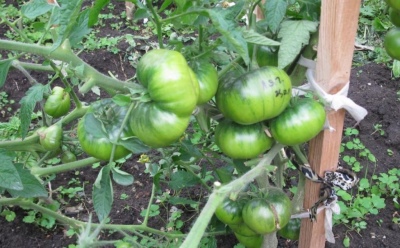
- Category: grade
- Growth type: indeterminate
- Appointment: fresh consumption, for pickling and preserving
- Ripening period: mid-early
- Ripening time, days: 111-115
- Growing conditions: for open ground, for film greenhouses
- Bush size: medium-sized
- Bush height, cm: up to 150
- Bush characteristic: powerful
- Unripe fruit color: green
The princess frog is a variety of green-fruited tomatoes that has a whole army of fans because of its excellent taste and good seed germination. However, to get a good harvest of this variety, the gardener will have to work hard.
Description of the variety
The princess-frog bush is powerful, of medium vigor, reaches a height of 150 cm.
The main qualities of the fruit
An unripe tomato has a green skin; upon reaching ripeness, the color becomes emerald green with a bronze tint. A green color indicates a high chlorophyll content in tomatoes. This substance has a healing effect on the human body, for example, enriches the blood with oxygen, strengthens the immune system, and rid the body of toxins and toxins.
In shape, the fruits are flat-round, slightly ribbed, the skin is thin, and this makes it difficult to transport and store tomatoes.
Taste characteristics
According to consumers, the tomatoes of the presented variety have a very pleasant exquisite taste. The pulp is multi-chamber, sweet, but with hints of sourness. The taste has some peculiarity - if the tomato is unripe, then it will be sour, while the overripe vegetable becomes very soft and crushed in the hand. Therefore, it is recommended to eat these tomatoes in ripe, but not overripe.
This variety is mainly used for fresh consumption. Despite the indication by breeders about the possibility of canning tomatoes, practice shows that this is problematic due to the thin skin of tomatoes.
Ripening and fruiting
This variety belongs to varieties with a medium early ripening period, you can harvest it 111-115 days after germination. Usually the collection falls in July-August.
Yield
The variety is considered high-yielding, with 1 sq. m. on average, it turns out to collect 6.5 kg.
The timing of planting seedlings and planting in the ground
Sowing is done in March-April. The seeds are planted in a 1-2 cm container, then the planting is sprayed with water, covered with a film, and removed to a dark place. When the first shoots hatch, the film can be removed and the container can be placed in a sunlit place.
Seedlings are picked when 2-3 true leaves appear. About 10 days before transplanting, you need to start hardening the plants. To do this, take them outside, increasing the time spent in the fresh air every day.
Transplantation to the site is carried out in warm weather. In a greenhouse, sprouts are usually planted in April-May, in open ground - in June.

Growing tomato seedlings is an extremely important process, because it largely depends on whether the gardener will be able to harvest at all. All aspects must be taken into account, from seedbed preparation to planting in the ground.
Landing scheme
Shoots are planted according to the 40x60 cm scheme. With this arrangement, crowding does not form, the culture feels comfortable.

Growing and care
The presented variety requires classical care, however, this variety is finicky, namely: a special love of warmth, therefore it is still recommended to grow it in a film greenhouse. The plant needs pinching and garter, and the best result is obtained when forming 2-3 stems.
Watering is done as needed. If the culture is planted in a greenhouse, then do not forget to regularly ventilate the room. The advantage of the variety is its high immunity to most common diseases, so it does not need additional preventive treatment.
Reviews
Despite the declared high yield, in practice, the Frog-princess variety cannot boast of an abundance of fruits. The same can be said about the weight of tomatoes - often the weight is below the indicated one. And also to the disadvantages of the variety, gardeners attribute poor keeping quality and the inability to use overripe tomatoes - they turn into porridge.
The pluses include the taste of tomatoes, as well as the fact that when fully ripe, they are easily peeled from the skin.




A plant needs different micronutrients at each stage of growth. All fertilizers can be divided into two groups: mineral and organic. Folk remedies are often used: iodine, yeast, bird droppings, eggshells.
It is important to observe the rate and period of feeding. This also applies to folk remedies and organic fertilizers.



























































































